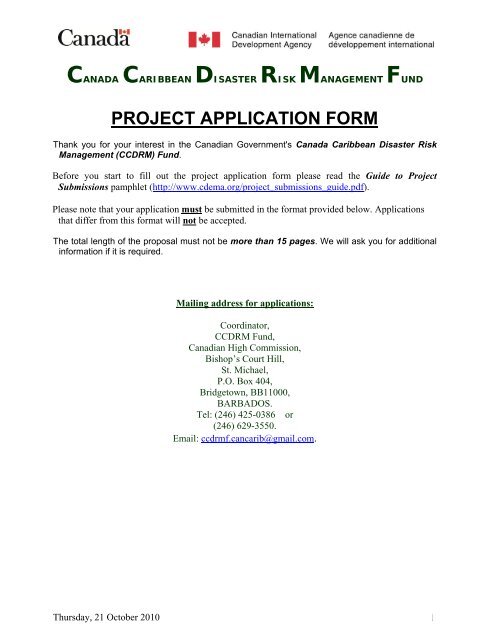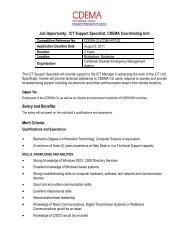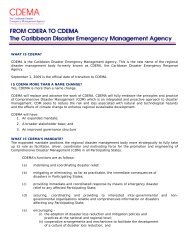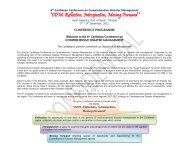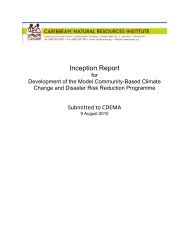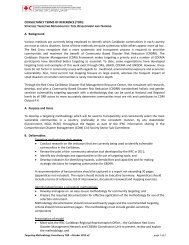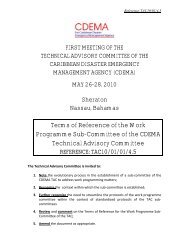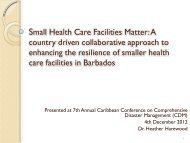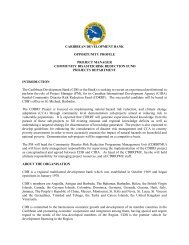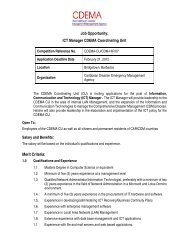PROJECT APPLICATION FORM - CDEMA
PROJECT APPLICATION FORM - CDEMA
PROJECT APPLICATION FORM - CDEMA
You also want an ePaper? Increase the reach of your titles
YUMPU automatically turns print PDFs into web optimized ePapers that Google loves.
CANADA CARIBBEAN DISASTER RISK MANAGEMENT FUND<br />
<strong>PROJECT</strong> <strong>APPLICATION</strong> <strong>FORM</strong><br />
Thank you for your interest in the Canadian Government's Canada Caribbean Disaster Risk<br />
Management (CCDRM) Fund.<br />
Before you start to fill out the project application form please read the Guide to Project<br />
Submissions pamphlet (http://www.cdema.org/project_submissions_guide.pdf).<br />
Please note that your application must be submitted in the format provided below. Applications<br />
that differ from this format will not be accepted.<br />
The total length of the proposal must not be more than 15 pages. We will ask you for additional<br />
information if it is required.<br />
Mailing address for applications:<br />
Coordinator,<br />
CCDRM Fund,<br />
Canadian High Commission,<br />
Bishop’s Court Hill,<br />
St. Michael,<br />
P.O. Box 404,<br />
Bridgetown, BB11000,<br />
BARBADOS.<br />
Tel: (246) 425-0386 or<br />
(246) 629-3550.<br />
Email: ccdrmf.cancarib@gmail.com.<br />
Thursday, 21 October 2010 1
CANADA CARIBBEAN DISASTER RISK MANAGEMENT FUND<br />
A: Application Cover Sheet (maximum 1 page)<br />
1. Project Title:<br />
2. Location of<br />
project (country,<br />
name of<br />
community):<br />
3. Name of<br />
implementing<br />
organization and<br />
address:<br />
4. Main contact<br />
person: (name,<br />
title, address,<br />
telephone, fax,<br />
email)<br />
5. Alternate contact<br />
person: (name,<br />
title, address,<br />
telephone, fax,<br />
email)<br />
6. Project Partners:<br />
(name, title,<br />
address,<br />
telephone, fax,<br />
email)<br />
7. Proposed Start<br />
Date (Month/<br />
Year):<br />
8. Budget:<br />
Guidance Notes:<br />
Contact information on the organization or organizations that will be working with or assisting<br />
your organization to implement this project.<br />
Funds requested from CIDA:<br />
(Local Currency)<br />
Funds and in-kind<br />
contributions:<br />
contributions from the<br />
community and pledges by<br />
other sources - partners,<br />
donors, government (Local<br />
Currency)<br />
Proposed End date:<br />
(Month/Year):<br />
9.1 A Brief<br />
Description of<br />
the Project:<br />
Total Budget: (Local Currency)<br />
(Add more lines as<br />
needed).<br />
9.2 Brief Summary of<br />
Expected Results:<br />
(Add more lines as<br />
needed).<br />
Describe the change in the level of disaster risk in the community that will result from this<br />
project? How will you measure this change to show that the project has been successful?<br />
What difference(s) will the community experience when the project is complete?<br />
Thursday, 21 October 2010 2
10 What are the main<br />
project activities<br />
that will allow you<br />
to get the results<br />
that you<br />
described above?<br />
(Add more lines as<br />
needed).<br />
Activity:<br />
How will this activity contribute to<br />
the reduction of disaster risk?<br />
:<br />
SECTION B. ABOUT THE ORGANISATION<br />
1. How many people are involved in your organisation/group? Please put numbers in the boxes below.<br />
Executive committee (Number) Members (Number) Paid staff (Number)<br />
2. Is your organisation registered with the<br />
Department of Cooperatives and Friendly<br />
Societies or the Companies Office or with<br />
any other government agency?<br />
□ Yes<br />
If yes, please<br />
indicate which<br />
agency?(please<br />
attach<br />
rules/constitution)<br />
□ No<br />
If no, does your group have<br />
a set of rules or a<br />
constitution? (please<br />
attach)<br />
3. When did your<br />
organisation/group<br />
start?<br />
4. What type of<br />
organization is<br />
applying for funding?<br />
What are the<br />
organizations<br />
objectives?<br />
What are the main<br />
activities in which the<br />
organisation or group<br />
has been involved?<br />
Who does the<br />
organization<br />
Represent?<br />
What role did women<br />
play in the<br />
development of the<br />
project proposal?<br />
5. Does your group<br />
have a bank<br />
account?<br />
□ Yes<br />
□ No<br />
Thursday, 21 October 2010 3
1. Describe<br />
the project that<br />
you want<br />
funded.<br />
2. What could<br />
stop the<br />
project from<br />
being<br />
completed<br />
successfully?<br />
3. Where will<br />
the project take<br />
place?<br />
4. Who will<br />
benefit from<br />
the project?<br />
SECTION C.<br />
THE <strong>PROJECT</strong><br />
Guidance Notes:<br />
i) Describe the main purpose of the project.<br />
ii) Clearly explain how the project will reduce the risk of disasters in the community and/or<br />
contribute to climate change adaptation.<br />
iii) What will change in the target community or communities when the project is<br />
successfully completed?<br />
iv) How long will to take to complete the project?<br />
v) What are the main activities of the project? How will each activity contribute the overall<br />
reduction in disaster risk?<br />
Guidance Notes:<br />
i) What could prevent the project from being completed successfully?<br />
ii) Identify the main risks (i.e. political, economical, social, organizational, financial,<br />
environmental, etc.) that could affect the successful implementation of the project?<br />
iii) What can be done to avoid these problems or reduce their negative effects on the<br />
project?<br />
Guidance Notes:<br />
i) Describe the community or region where the project will take place.<br />
ii) Describe the disaster risk problems that your project will try to solve for the community<br />
and how the problem affects men, women, children, and the elderly in the community.<br />
iii) How will the project solve the disaster risk problems?<br />
iv) Why should this project be funded?<br />
Guidance Notes:<br />
i) Who will benefit from the project?<br />
ii) How has the project meet the different disaster risk reduction needs of the men, women,<br />
children, and elderly in the community?<br />
iii) What will the project change for the men, women, children, and elderly in the community?<br />
iv) How were the men, women, children, and elderly in the community involved in the<br />
decision to seek funding and in the planning and design of the project?<br />
v) How will the men, women, children, and elderly in the community participate in the<br />
implementation of the project?<br />
vi) What consideration has been given to promoting equal participation of women and men?<br />
vii) List the names and responsibilities of the key individuals involved in project<br />
implementation.<br />
i) How can the project contribute to the social or economic improvement of the community?<br />
5. Social and<br />
Economic<br />
Benefits:<br />
Thursday, 21 October 2010 4
6. Project<br />
Sustainability:<br />
Guidance Notes:<br />
i) How long after your project has ended will the community have a reduced level of disaster<br />
risk?<br />
ii) How will you ensure that the community continues benefits from the project after it has<br />
ended?<br />
iii) What arrangements will be put in place to ensure that the community continues to benefit<br />
from the project’s disaster risk reduction measures after the project ends?<br />
iv) Does the long-term success of the project depend on future actions or involvement of the<br />
community, partner agencies, or the government?<br />
v) Does continued disaster risk reduction require a formal agreement with any of these<br />
groups?<br />
vi) What arrangements have been made for meeting the costs of ongoing maintenance?<br />
7. Project<br />
Maintenance.<br />
i) What is the plan for maintaining the project after it has been completed?<br />
ii) Who will be responsible for maintaining the project after it has been completed?<br />
iii) Where will the funds to maintain the project come from?<br />
8. Reporting<br />
Project<br />
Progress?<br />
9. Impact of<br />
project on the<br />
environmental:<br />
i) How will you advise the CCDRM Fund of the project’s progress and any problems that<br />
are being experienced?<br />
ii) How often will this be done?<br />
Guidance Notes:<br />
i) Will the project result in damage to the environment (forests, reefs, rivers, beaches,<br />
breeding grounds or nesting sites of animals etc.)?<br />
ii) Does the project involve construction, excavation, land clearing, removal of vegetation, or<br />
modification of a site?<br />
iii) Is the site within 98 feet (30 m) of a stream, river, pond, lake or the sea?<br />
iv) What type of pollutants could the project release into the environment?<br />
v) How will the project benefit or improve the environment (e.g. tree planting, prevention of<br />
soil erosion).<br />
Guidance Notes:<br />
i) Describe any relevant projects already implemented by the submitting organization,<br />
including the source of funding, how the project was implemented, and the results.<br />
ii) Give information on any previous projects supported by the CIDA: When was the project<br />
funded? What was the size of the budget? Has the project been successfully completed,<br />
etc.?<br />
10. Previous<br />
Experience<br />
Thursday, 21 October 2010 5
i) Show the activities that will lead to the completion of the main project activities<br />
shown in the project budget. Indicate when each activity will begin and end e.g. an<br />
activity may start in week one and end in week three of a six month project.<br />
ii) You may wish to organize your work plan in a table similar to the one shown below.<br />
Activity<br />
Project Start-up<br />
Project Partner Meetings/Finalizing Process<br />
and Forms<br />
Start-up meeting with villages<br />
Engineer first meeting with villages<br />
Wk<br />
1<br />
Wk<br />
2<br />
Wk<br />
3<br />
Wk<br />
4<br />
Wk<br />
5<br />
Wk<br />
6<br />
Wk<br />
7<br />
Wk<br />
8<br />
Wk<br />
9<br />
Wk<br />
10<br />
Shelter Restoration<br />
1. Roof repairs<br />
2. Doors and windows<br />
3. Water supply<br />
4. Drainage<br />
11. Work Plan.<br />
Hillside Stabilization<br />
1. Secure seedlings and Vetiver Grass<br />
2. Prepare hill-side contours<br />
3. Prepare contour lines for planting<br />
4. Plant seedlings and Vetiver Grass<br />
5. Water and weed seedlings<br />
6. Monitor seedling growth<br />
7. Report<br />
Rainwater Harvesting and Storage<br />
1. Install water platforms<br />
2. Install guttering on buildings<br />
Other Ongoing Management<br />
Ongoing project administration<br />
Ongoing project monitoring/assistance<br />
Mid-project regional village meeting<br />
Final regional village project meeting<br />
Monthly Project Updates<br />
End of Project Report<br />
Thursday, 21 October 2010 6
D: Project Budget (maximum 3 pages):<br />
Please note that the budget that you present as part of the project proposal must follow the format<br />
provided below. If this format is not used there is a risk that your proposal will not be<br />
considered.<br />
Budget Headings:<br />
a) “CIDA” – in the column headed “CIDA” indicate that costs of the resources being<br />
requested from the CCDRM Fund.<br />
b)<br />
c) ““Recipients”: The amount of money or the value of the in-kind contributions that your<br />
organization and/or the beneficiary community have agreed to commit to the support of<br />
the proposed project.<br />
d) “Others”: Specify the resources that your partners, and/or other donors, and/or the<br />
government have agreed to commit to the support of the proposed project.<br />
1. The Project Budget<br />
Type of activity<br />
(specify details)<br />
CIDA’s<br />
Contribution<br />
$CDN<br />
(the amount<br />
being<br />
requested from<br />
the CCDRM<br />
Fund)<br />
Applicants<br />
Contribution<br />
(the<br />
contribution<br />
from your<br />
organization<br />
and/or the<br />
community)<br />
Partner<br />
Pledges or<br />
Contributions<br />
(the contribution<br />
pleaded by NGO<br />
partners,<br />
government<br />
agencies or<br />
donors)<br />
Totals<br />
Fees/ salaries / labour<br />
costs<br />
Training activities<br />
Equipment / Materials<br />
Administration<br />
expenses<br />
Other (specify)<br />
Totals<br />
Thursday, 21 October 2010 7
2.Matching Funds :<br />
Guidance Notes:<br />
If the total cost of the project is more than the amount you are requesting from the CCDRM<br />
Fund indicate how your organization or other organization(s) (donors, partners) will fund<br />
the difference. The organizations will be required to provide written confirmation of this<br />
support.<br />
3.What is the target community contributing to the project?<br />
Item<br />
Cost/In-kind<br />
contribution<br />
Total<br />
SECTION E. DECLARATION<br />
Declaration<br />
By submitting this application, you are confirming the following:<br />
• The information in this application is correct.<br />
• This application has been prepared with the knowledge and consent of the<br />
organisation’s/group’s Executive Committee.<br />
• This application has the support of the organisation’s/group’s membership.<br />
Signature of person submitting the<br />
application<br />
Print Name<br />
Date<br />
Position within the<br />
organisation:<br />
The following should be completed by the Chairperson of your organisation/group. If the<br />
Chairperson is submitting this application, it should be completed by another member of the<br />
Executive Committee<br />
Signature Print Name Date<br />
Position within the<br />
organisation:<br />
Thursday, 21 October 2010 8


